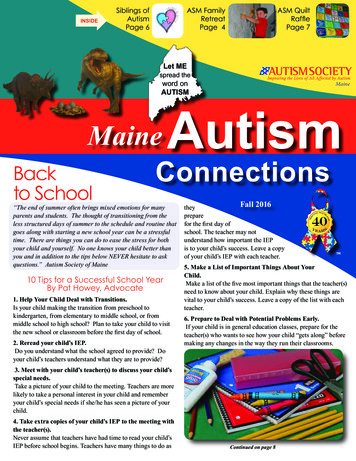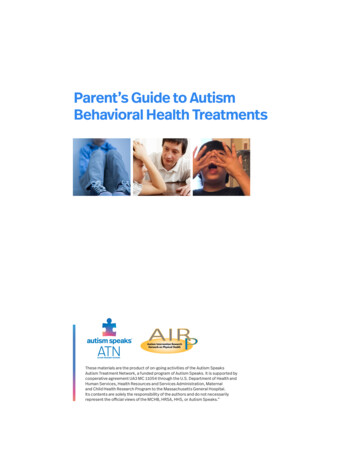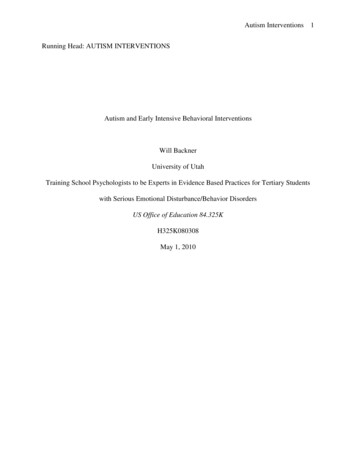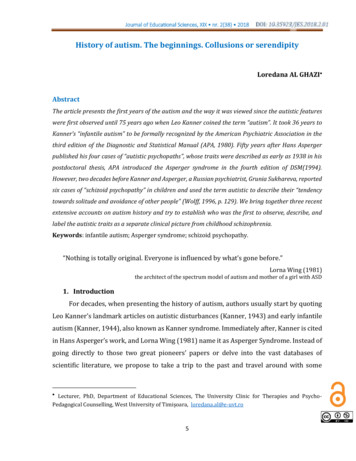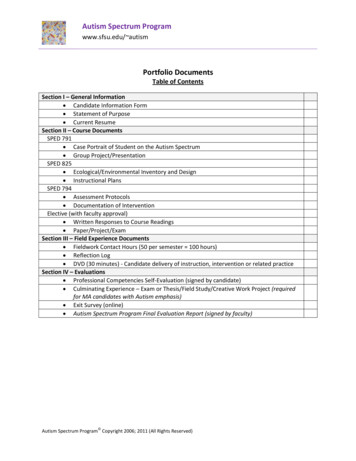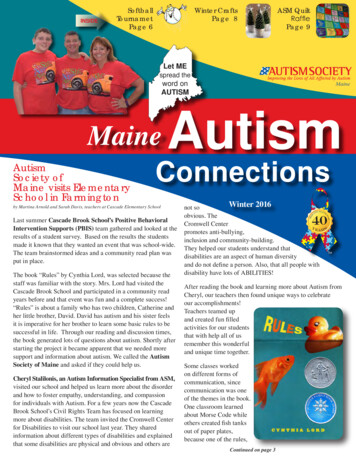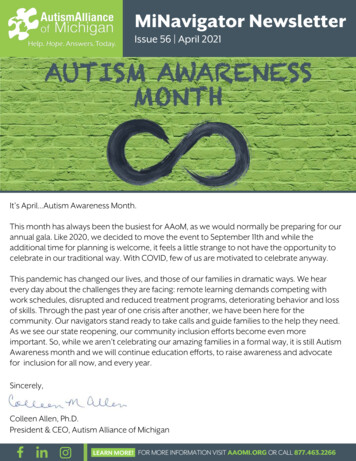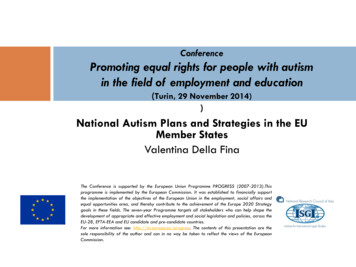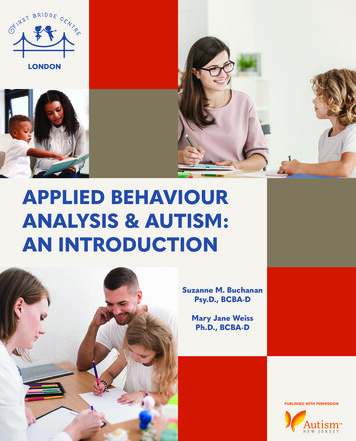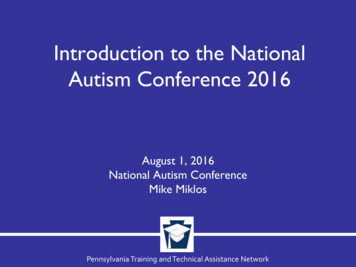
Transcription
Introduction to the NationalAutism Conference 2016August 1, 2016National Autism ConferenceMike MiklosPennsylvania Training and Technical Assistance Network
Welcome to the National AutismConference!
This session Will provide a review of some basicinformation to define common technicalterminology that you may hear across manysessions Will provide a review of the conferenceschedule and highlights related to areas ofinterest * beginner I Intermediate A advancedVideo
What is Autism? Let’s look at the definition found in DSM V That’s DSM 299.00 in case you were wondering! Keep in mind that no child is “autism”: each child isan individual “You’ve met one child with autism, you’ve met onechild with autism” P. Gerhardt
What Are Autism Spectrum Disorders? (DSM VSummary) Social-Communication deficits and Repetitive Behaviors:––––responding inappropriately in conversationsmisreading nonverbal interactionshaving difficulty building friendships appropriate to their agemay be overly dependent on routines, highly sensitive to changes in theirenvironment, or intensely focused on inappropriate items The symptoms fall on a continuum (from mild to severe) Variations in symptoms and behaviors from person to person Symptoms occur from early childhood, even if those symptomsare not recognized until later Adapted from: Disorder%20Fact%20Sheet.pdf
What are Autism Spectrum Disorders? Developmental Disability Diagnosis derived from behavior– No brain scan or blood test– Assumed biological disorder most likely of geneticorigin characterized by qualitative differences in: Social communication Repetitive and stereotyped behaviors
What does the literature say abouteffective instruction and autism? National Autism Center Standards Reports(2009; 2015) probably provides the mostthorough and relevant summary
National Autism Center Standards ReportPhase 2: “The National Autism Center has adopted the definition of evidencebased practice offered by David Sackett and his Colleagues: evidencebased practice as ‘the integration of best research evidence, professionaljudgment, and values and preferences of clients.’” p.80 “The combined results of NSP1 and NSP2 include data from more than1000 studies. This is the largest review of its kind for individuals withASD.” p. 80 The report and evaluation methods can be retrieved standardsproject/phase-2/
Evidence-Based Interventions by Quantity of FindingsSMRS Research FindingsInterventions by Quantity500453Quantity of Articles400300200100029815579512837 481143 46341212021153635142121103121 243InterventionPhase 1Phase 211 6 173 101311 2 1310 2 126 5 11
NAC Standards Report Conclusions (2009): Approximately two-thirds of the Established Treatmentswere developed exclusively from the behavioralliterature (e.g., applied behavior analysis). Of the remaining one-third of the Established treatmentsstudies are derived predominantly from thebehavioral literature. This pattern of findings suggests that treatments fromthe behavioral literature have the strongest researchsupport at this time PATTAN Autism Initiative focuses primarily oninterventions derived from or relying on principles ofABA
Further Evidence for ABA and Autism Treatments National Autism Center Standards ReportMaine Administrators ReportMissouri Autism GuidelinesNumerous research articles published in awide range of behavioral, educational anddisability focused peer reviewed journals Student level data: probably the strongestargument for ABA
Autism “A fad magnet” (Metz and Mulick, 2005) Be wary of quick fix interventions: someexamples.––––––Sensory IntegrationFacilitated communicationVaccines/Mercury cause AutismRapid promptingCertain biomedical interventions (chelation; diets)And on and on .
Sessions on Evidence and Implications Session 18: Francesco DiSalle: fMRI Data andVerbal Operants A Session 19 Alice Shillingsburg: EthicalConsiderations * Session 24 Perry Zirkel; Legal Updates I Session 36: Various presentersEvaluation/Reevaluation reports and IncreasingGraduation Rates * Session 37: Anniversary Panel *
Sessions on Evidence and It’s Implications Session 51: Jose Martinez Diaz, Motivation andits relation to response variability I Session 78: A. Banzhaf, Ensuring effectiveschool-based interventions * Also: website PSU archives http://legacy.wpsu.org/live/archive/
Quality Educational Programs: Key Features Focus on addressing core deficits of autism Provide high rates of active studentresponding Build Skills: explicit instruction Use of positive reinforcement/skill building Honor student interests, personality and skills Data driven Collaborative! Video Harrisburg case studies
Sessions on Quality Instruction Session 27: Ashley Harned, Effective GroupInstruction and Direct Instruction * Session 31: M. Ampuero &j. Jackson, Generalizationand Natural Environment Training * Session 33: K. Collins, Tactics for ClassroomManagement * Session 38: A. Foor, Instruction Basics * Session 55: T. Foust and team, An integratedapproach to teaching *
Sessions on Quality Instruction Session 68: Aimee Miller, Setting the stage forsuccess * Session 69: Jared Campbell, Skill sequences inMathematics Instruction * Session 70 (full day): Amiris DiPuglia, ProgrammingConsiderations I Session 84: Tina Sidener: Establishing NaturalReinforcers I Session 85: Jared Campbell, The Language ofMathematics, Math Concepts *
A Brief Review of ABA ABA is not a thing or a procedure It is a system of evaluating how the behaviorof individuals systematically changes in relationto the ongoing and past situations in which theperson behaves.
So What is ABA? The application of science of learning to sociallysignificant human behavior– Applied: socially significant– Behavior: relation between environmental events and whatpeople do– Analysis: uses scientific methods to establish and evaluateapplications– It is a process, not necessarily a procedure Any intervention/method can use ABA; however, notall interventions do!
ABA and Board Certification(Behavior Analysis Certification Board) What is a BCBA?What is a BCaBA?What is a RBT?Why are they helpful?Session 13: Iser DeLeon, Recent Developmentsat the Behavior Analyst Certification BoardImmediately after this session. I
Applied Behavior Analysis Builds skills to help people be moreindependent Helpful across:education, business, health practices (e.g.smoking cessation, weight loss, reducing obsessions,etc), animal training (e.g. pouched rats and landmines), environmental sustainability (e.g. towelreuse in hotels and litter reduction), occupationalsafety, gun safety, transportation safety, andmore .
ABC Analysis A Antecedent (before behavior) B Behavior (what a person does:observable and measureable) C Consequence (after behavior)video ABC analysis
Behavior Analysis Key Terms Antecedent– Motivating Operation Unlearned (UMO) Transitive (CMO-T) Reflexive (CMO-R)– Discriminative stimulus (Sd) Stimulus control Instructional control– Prompt
Behavior Analysis Key Terms Consequence––––––ReinforcementPositive ReinforcementNegative ReinforcementPunishmentExtinctionSchedules of Reinforcement (for instance,continuous, variable ratio, interval)
Why an ABC Analysis is Helpful It avoids having to guess about un-observable events (what isgoing on “inside the person”) It is optimistic! It allows for checking to see that interventions really work!
Some Educational Applications of ABA Mand Training Discrete Trial Training– Errorless Teaching– Error correction Direct Instruction Social skill building Altering a school culture
Social Communication and Autism The Basic Verbal Operants Speaker ation (with sign language) Listener Skills– Listener Responding (Receptive) And Complex Skills– Multiple control– Atomic repertoires!!! (Palmer, 2012)Videos 5-11
Sessions on the Analysis of Verbal Behavior andComplex Language Session 15 Mark Sundberg : TeachingIntraverbal Behavior I Session 16: Laura Yates: Intro to SignLanguage for ASD * Session 21 Josh Pritchard: StimulusEquivalence and Complex Language I Session 23 John Esch: Fun Group Games forLanguage Development *
Sessions on the Analysis of Verbal Behaviorand Complex Language Session 39: John Bernard, ExecutiveFunctioning I Session 42: Charles Catania, ABCs of VerbalBehavior I Session 34 and 46: Francesca degli Espinosa,Teaching children to talk about private eventsA Session 47: S. Lechago, Emergent Respondingand Training VB I
Sessions on the Analysis of Verbal Behaviorand Complex Language Session 49: Vince Carbone Alternativecommunication methods I Session 71 C. Sundberg: Teaching SignLanguage I Session 77: J. McElwee & S. Ming, DerivedRelational Responding and GenerativeResponding I Session 82: A. Dunn-Nacarelli & H. Forbes,The VB-MAPP, an Overview *
What is a mand? Common terms: RequestAsking for somethingA questionDemandingInquiringCommanding
Mand Videos Mand TrainingIntroduction to Mand Training“Video Sharae and Mike”
Sessions on Mand Training Session 14: M. Miklos, Mand Training Basics * Session 25 David Roth, Advanced MandTraining I
A Functional Approach to LanguageMand: Asking for something (A preferred toy,activity, information, etc.)Tact: labeling what you see, hear, smell, taste, ortouchEchoic: repeating what has been saidIntraverbal: responding with words to thingsthat have been said (conversation, answeringquestions, word associations)
A Functional Approach to LanguageListener responding/receptive: Followingdirections, selecting things named or otherwisebehaving as a listener without speakingMotor Imitation: Doing the same thing someoneelse does.Match to Sample: Putting an item or picture inproximity of something with sharedcharacteristics.
Some Words About Data Key aspect of ABA: understanding some of this may help youat this conference! Human memory is quite fallible Data helps us remember what happened Data helps us see patterns of performance and behaviorchange One might not need data on every behavior, but without datapeople often end up guessing Data systems should not interfere with instruction, ratherthey should support teaching and learning
Types of Data CountsTimingsContinuousSampledSkill ProbesCumulative responses or skills acquired
The Analysis: Functional Relations Graphs are very valuable– They allow a quick check of how a program orintervention is working Tests to determine if things are working:– If I change the way I teach, does it consistentlychange what the student does?– Does the intervention function to changebehavior?
Interpreting Data and Graphs Graphs: Y axis; X Axis Graphs: Level, Trend; Variability Types of studies:– Reversals (AB; ABA, ABAB, ABAC, etc)– Multiple baseline– Changing Criteria Intergroup Design– N (number of participants)– Statistical analysis (significance)
Dylan: Cumulative MandsDylan: Cumulative /7642Total Cumulative Skills in 20 weeks: 68 (20 64203/510Dylan: Cumulative ImitationSkillsDylan: Cumulative MTS /1111/27Number of Targets MasteredDylan: Cumulative Echoic Skills3/19004/9Number of Mastered Targets25
Example: Decision Rules10090BaselineIntervention 1Intervention 28060Test ScoreX5040Aim line3020X1002468 1012Successive Days141618
Treatment Fidelity and Staff Training Instruction and data will only result in goodoutcomes if interventions are implementedwith fidelity Fidelity of implementation is accomplishedthrough:– Competency-based training– On site guided practice/feedback– Verification of treatment fidelity
Motor Imitation Procedural Fidelity ChecklistDate: Instructor: Student:Observer 1: Observer 2: IOA%Error CorrectionTeaching ProceduresOrganizationYES NO N/A1.2.3.Is instructional area neat and sanitized?Does instructor have all materials needed for instruction organized and ready?Does instructor have a variety of valuable reinforcers available?4.5.8.When teaching, does instructor present the SD and prompt the correct response?Once the student complies with the prompt, does the instructor re-present the SD with no prompt or afaded prompt (transfer trial)?Is transfer trial followed by distractor(s)?Following distract trials, does the instructor re-present the SD with no prompt or a faded prompt aspresented in transfer trial (check trial)?Does instructor model the action to be performed for the prompt, transfer and check trials?9.Does instructor reinforce at set VR schedule? VR:10.11.12.Does instructor use a prompt that results in correct response?Does instructor differentially reinforce (better reinforcement) target responses?Does instructor end the trial and ensure student is in neutral position (use ready hands if needed)?6.7.13. Does instructor re-present the SD and prompt the correct response?14. Does instructor prompt student if no response occurred within 2 seconds for a previously mastereditem?15. Does instructor model the action to be performed for the prompt, transfer and check trials duringerror correction?Notes:/15Percentage of Y’s:
Social Skills Most social skills involve communicationLanguage instruction is social skill trainingPeer to Peer manding often a place to startEvidence based methods of addressingcomplex social skills is important Look for interventions that avoid rotelearning.
Sessions on Social Skill Training Session 17; Justin Leaf Designing andimplementing behaviorally based social skills* Session 22 Amy Wetherby Early SocialInteraction Project * Session 23: John Esch Games and social skills * Session 48: Rachel Kittenbrink, Buildingfunctional social skills * Session 72: Tammy Kasper, Friends and fitnessI
Behavior management FBA PBSP Function Based– Motivation– Competing skill– Making PB ineffective and inefficient– Video 13
Sessions on Behavior Management Session 28: Dave Wilder, Establishing rule-following in home,school & community I Session 41: Brian Iwata, Functional analysis of problemBehavior I Session 44: William Ahearn, Reducing stereotypicvocalizations I Session 50: Brian Iwata, Problem behavior maintained byautomatic reinforcement I Session 79: Chris Skinner, Procedures to prevent and remedyproblems for individuals with high functioning autism *
Life skills and Activities of Daily Living Functional Approach These are critical skills: becoming toilettrained, for instance, alters likely trajectory Safety skills in this day!
Sessions on Life Skills and Activities of Daily LivingSession 29: William Ahearn, Feeding Problems*Session 73: Sandy Jin, Addressing sleepproblems*Session 74 & 83: (all day) F. Cicero, Promotingappropriate sexual behaviors ISession 81: Barry Morgenstern, TeachingFunctional Skills*
Transition Programming As children enter middle and high school it iscritical to begin planning for the transition tolife, career and education opportunitiesbeyond public education. Programming for these opportunities remainsrooted in evidence base.
Sessions Related to Transition and Careerand College Ready Session 20: J. T. Brown and P. Garland Transition to College* Session 32: T, Regli; P. Monoghan & J. Velasco PreparingTransition age youth for employment * Program 40: Willow Hozella, Programming for SecondaryStudents: Employment and Life Skills considerations * Session 48A: L. Ackles & J. Rinco College students inAnimation/Technology * Session 59: A. Cash & A. Banzhaf, Teaching Functional Skillsto High School Students *
Sessions on Early Intervention Session 22: Wetherby, Early Social InteractionProject * Session 35: Ilene Schwartz, EI/ECSE and ABAEthics I Session 52: K. Herb & M. Mikus, Earlyintervention: your first steps * Session 56: J. Deitz & K. Bene, Flow of QualityInstruction in Early Childhood Class *
Sessions on Teaming and Training Session 45: April Kissamore, Innovations in Parentand Staff training * Session 53: N. Verbos & A. Adnopoz, Motivate this!training staff * Session 54: L. Johnson & M. MacCrory, Analyze this!motivating and training Staff * Session 55a: J. Bennet 7 team, It Takes a Village * Session 83: Laura Turner, Effective Behavior AnalyticSupervision I
Teaching Speech and Articulation Skills Session 81: Tammy Kaspar, Evidence basedspeech production training *
Don’t Forget!! Session 37: Anniversary Panel! * Session 67: Posters! * Session 86: Closing Keynote! *
Remember: PATTAN staff are here to help! Ifyou have any questions or concerns, please ask! Thank you for attending this session and hopeyou have a productive and enjoyableconference experience!
Contact Informationwww.pattan.netMike Miklosmmiklos@pattan.net717 901-2256Commonwealth of PennsylvaniaTom Wolfe Governor
National Autism Center Standards Report Phase 2: "The National Autism Center has adopted the definition of evidence-based practice offered by David Sackett and his Colleagues: evidence based practice as 'the integration of best research evidence, professional judgment, and values and preferences of clients.'" p.80


